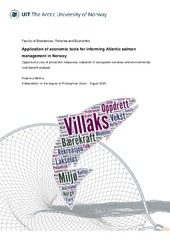| dc.contributor.advisor | Aanesen, Margrethe | |
| dc.contributor.author | Nikitina, Ekaterina | |
| dc.date.accessioned | 2020-10-01T10:29:29Z | |
| dc.date.available | 2020-10-01T10:29:29Z | |
| dc.date.embargoEndDate | 2025-10-23 | |
| dc.date.issued | 2020-10-23 | |
| dc.description.abstract | This thesis explores various aspects of the application of economic analysis to Atlantic salmon management in Norway. The purpose and contributions are twofold. On the one hand, the thesis seeks to improve economic toolbox used to analyse environmental-economic trade-offs. On the other hand, it yields specific conclusions and recommendations for the case of Atlantic salmon management in Norway and environmental management in general. The questions investigated here concerns opportunity costs of conservation, valuation of ecosystem services and the application of cost-benefit analysis in practice. The research is largely related to the problem of “farmed-wild salmon” trade-off, where the recently introduced aquaculture regulations (“Traffic light” system) are central. The research applies both quantitative and qualitative methods.
A general model for the opportunity cost in the presence of externalities is proposed and challenges in its estimation, mainly related to the complexity of ecological-economic links, are discussed. It is found that wild salmon conservation under the new regulations is both economically and ecologically inefficient. It is argued that an analysis of costs and benefits would reveal potential inefficiency at an early stage. However, the research finds that application of cost-benefit analysis is hindered by knowledge gaps, ethical, political and technical constraints. In particular, knowledge gaps concern the values of ecosystem services. The thesis investigates potential affective bias in the valuation of Atlantic salmon with stated preference methods. The bias is linked to the awareness of the good due to the public debate surrounding wild and farmed salmon controversies, and the prevalence of non-market values. Addressing the knowledge gaps would improve the applicability of economic tools. However, it is also required that other constraints are taken into account. | en_US |
| dc.description.doctoraltype | ph.d. | en_US |
| dc.description.popularabstract | Wild Atlantic salmon is an important species for Norway. It is fished for recreation and for income, and admired as a cultural symbol. As the stock declines, wild salmon conservation is placed high on the agenda. However, conservation of the species is a complex issue that involves trade-offs between environmental and economic values. For example, it costs to lime rivers or to eradicate invasive parasites. The costs can also be indirect, which is illustrated by the new aquaculture regulations, “Traffic light” system, where reduction of salmon farming is required in areas with high environmental impacts. Economic analysis of such trade-offs is an important input to the decisions regarding salmon management. The research presented in this thesis explores different aspects of such analysis. It applies statistical methods, experiment and interviews to find ways of improving the economic toolbox. The research also yields conclusions directly relevant for the management of Atlantic salmon | en_US |
| dc.identifier.isbn | 978-82-8266-186-7 | |
| dc.identifier.uri | https://hdl.handle.net/10037/19527 | |
| dc.language.iso | eng | en_US |
| dc.publisher | UiT The Arctic University of Norway | en_US |
| dc.publisher | UiT Norges arktiske universitet | en_US |
| dc.relation.haspart | <p>Paper 1: Nikitina, E. (2019). Opportunity cost of environmental conservation in the presence of externalities: Application to the farmed and wild salmon trade-off in Norway. <i>Environmental and resource economics, 73</i>(2), 679-696. Also available at <a href=https://doi.org/10.1007/s10640-018-0278-0>https://doi.org/10.1007/s10640-018-0278-0</a>. Submitted manuscript version available in Munin at <a href=https://hdl.handle.net/10037/14484>https://hdl.handle.net/10037/14484</a>.
<p>Paper 2: Nikitina, E. (2019). Policy context as a factor of bias in the valuation of environmental goods–a dual-process theories perspective. Journal of Environmental Planning and Management, 62(5), 779-796. Published version not available in Munin due to publisher’s restrictions. Published version available at <a href=https://doi.org/10.1080/09640568.2018.1441813>https://doi.org/10.1080/09640568.2018.1441813</a>. Accepted manuscript version available in Munin at <a href=https://hdl.handle.net/10037/14486>https://hdl.handle.net/10037/14486</a>.
<p>Paper 3: Nikitina, E. & Aanesen M. (2020). What knowledge is needed to improve applicability of environmental cost-benefit analysis? Insights from a comparative study of two cases in the Atlantic salmon management in Norway. (Submitted manuscript). | en_US |
| dc.rights.accessRights | embargoedAccess | en_US |
| dc.rights.holder | Copyright 2020 The Author(s) | |
| dc.rights.uri | https://creativecommons.org/licenses/by-nc-sa/4.0 | en_US |
| dc.rights | Attribution-NonCommercial-ShareAlike 4.0 International (CC BY-NC-SA 4.0) | en_US |
| dc.subject | VDP::Social science: 200::Economics: 210::Economics: 212 | en_US |
| dc.subject | VDP::Samfunnsvitenskap: 200::Økonomi: 210::Samfunnsøkonomi: 212 | en_US |
| dc.title | Application of economic tools for informing Atlantic salmon management in Norway. Opportunity cost of protection measures, valuation of ecosystem services and environmental cost-benefit analysis. | en_US |
| dc.type | Doctoral thesis | en_US |
| dc.type | Doktorgradsavhandling | en_US |


 English
English norsk
norsk

